
Millet Village Attappady, Kerala: Choice for Healthy Food Consumption, Food Security, Livelihood, Income and Employment
*Corresponding Author(s):
Sreeni KRProject Manager, Pay Agri Innovations Pvt. Ltd., IITM Research Park, Chennai, India
Email:krsreeni72@gmail.com
Abstract
Millets are thought to be the first cereal grain used for household uses and are a significant component of the ancient healthy food system, particularly in the Attappady region. The indigenous people of Attappady dwell in 192 Ooru villages (Hamlets). The three main ethnic groups in the region are Irula, Muduga, and Kurumba, with a combined area of 735 km2 (284 sq mi). When the Kerala Forest Act went into effect in 1962, the tribal’s were relocated to Oorus (hamlets), and ownership was graded for land that was actually being farmed by the relevant family. The Adivasis, or indigenous peoples, have reportedly gone through repeated cycles of agrarian crises and sufficiency, according to colonial documents from the early 20th century. The entire food system has changed, and tribal people have abandoned all traditional farming and food ways as a result of being exploited by fast food and alcoholism. A growing number of health problems, such as anaemia, malnutrition, and the risk of miscarriage, sickle cell disease, abortion risk, congenital diabetes, and infant mortality due to underweight, have emerged as a result of numerous alienations that have significantly impacted their way of life, agricultural practices, and food culture. Millets offer consumers a variety of benefits, including food security, food safety, economic security, and protection from many diseases. The Indigenous people' traditional farming methods have recently come to be acknowledged as one of the food practices that promote climate resilience. The study looks at how the millet village project, which gives tribal people access to traditional, wholesome food and a means of income and livelihood , aids in the preservation of traditional millet varieties, diverse environmental adaptation, organic farming, and food security.
Keywords
Attappady millets, Finger millet (Ragi); Great Millet/ Indian Millet- Sorghum; Hill Value; Kudumbashree Mission; Little millet (Chama); Millet Hamlet
Introduction
The "Millet Hamlet" initiative, which started in 2013, is still ongoing and attempts to revitalise traditional tribal agriculture in Attapady's village. Ragi (finger millets), Chama (small millet), and Cholam (sorghum) are major millets now being grown on 850, 600, and 600 hectares, respectively. Millets are a kind of extremely nutritious small-grained cereal food crops that are cultivated in marginal or low-fertile soils with organic fertilisers and insecticides. The tribal community's food and nutritional security is greatly facilitated by these crops. The Scheduled Tribes Development Department and the Agriculture Department began collaborating to put it into practice. Agali, Sholayar [1], and Pudur are the three panchayats that make up the 2500 hectare project. More than 1067 JLG groups were formed in three panchayaths. Since the millet initiative at Attapadi began, the indigenous community's infant mortality rate has decreased after the consumption of their traditional food. Millets, a highly nutrient-dense cereal, will help farmers adapt to climate change and support small and marginal farmers.
Understanding millets program at attapadi
Most millets are grown during the Kharif (May to August) and Rabi (November to April) seasons. Because millets are rain-fed crops grown in regions with little rainfall, their significance for long-term agriculture and food security is emphasised. The major communities are settled at 192 hamlets inhabited by the Irula, Muduga, and Kurumba tribes. The organisation began acquiring, processing, packing, labelling, and marketing value-added millet finished products under Hill Value, which is backed by Kudumbashree Mission, in addition to millets, pulses, oilseeds, vegetables, and apiculture. The socioeconomic growth of hamlets will ultimately come from the Project's implementation. Initially, they had 663 JLGs, 8026 Tribal members, 126 ooru samithis and 4 Panchayath Samithis However, by 2021, those numbers had expanded to 1067 JLGs, 4268 members, and 250 ooru samithis.
All of these millets have a shorter growing season and can complete their life cycles in 2 to 4 months. They can also adapt to a variety of cropping methods and can change with the environment, especially during the monsoon.
Objectives
- To gain knowledge about how farmers' lives have changed in terms of their ability to support themselves, generate revenue and employment, and improve the consumption of traditional foods.
- To determine the number of people who consume millets in Attappady and the regularity with which they do so.
- To learn about the effects of millet consumption, particularly among children and women.
- The current key difficulties are centered on enhancing community health, ensuring food security and safety, increasing energy supply, reducing malnutrition, and other issues.
- To gain a better understanding of how consumers feel about the price of millets and millet-based goods.
- The role of "Hill Value" in increasing the value of tribal farm products to support a better standard of living [2].
Seasons to grow
Millets require very less water as compared to rice and wheat and considered drought tolerant crops. Most of the millets are Kharif season crops (sown during May-June) and come to maturity during September to October. Most of these crops give good yields during Rabi season (October-March) and summer season (January-April).
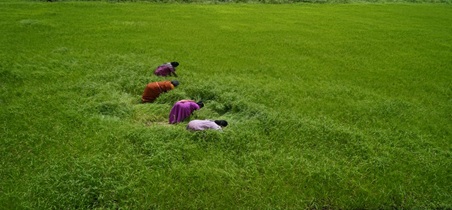
Materials and Methods
Study area
Attappady, a notable woodland location in Kerala and the millet village of Kerala, is chosen as the study area. It is located in the northeastern part of Palakkad. One of the 43 tribal development blocks in India with predominance of tribal people is the Attappady block. The Attappady tribes live in Ooru, a collection of little nuclear communities. On average, each Ooru has 50 dwellings that are built in rows and are near to one another. The Irulas form the majority among the tribes and live in 144 hamlets.
Study sample
The study was conducted in three purposively selected panchayats of the Attappady tribal developmental block namely Attappady I (Agali panchayat), Attappady II (Pudur panchayat) and Attappady III (Sholayur panchayat).
One hundred tribal families were randomly selected from each panchayath. Thus a total of 300 randomly selected tribal families formed the study sample [3].
Farming practices of tribal farmers
After the implementation of the millet village program, the majority of tribal farms gradually reverted to traditional indigenous methods such the use of traditional seeds, hand weeding, intercultural activities using traditional instruments, etc. Farmers in the neighbourhood exchange the traditionally preserved seeds. Tribal societies frequently engage in this practice because it preserves seeds for one to two seasons. The tribes' traditional millets, including finger millet, little millet, and great millet, were found to grow best in hot, dry climates and to have excellent climatic resilience. Another important result was that the majority of tribal farmers saw agriculture as a process of coexistence with environment rather than just an economic activity. Instead of being driven by the economics of yield and profit [4], their production practices focused on growing food without endangering the environment, the land, or the ecosystem and as part of believe system.
Classification Of Millets
The millets are classified as major millet and minor millets. The major millets include sorghum (jowar) and pearl millet (bajra). The finger millet (ragi/mandua), foxtail millet (kangni/Italian millet), little millet (kutki), kodo millet, barnyard millet (sawan/jhangora), are categorized under minor millets. . They are coarse grains and a huge repository of protein, fibre, vitamins and minerals (like iron, phosphorus and zinc). Major millets grown at Attapadi are Finger millet (Ragi), Little Millets (Chama) and Great Millet (Sorghum). Types of Millets cultivated at Attappady (Table 1).
|
Scientific name |
Eleusine Coracana |
|
Common Name |
Ragi (in Kannada, Telugu and Hindi), also Mandua/Mangal in Hindi, Kodra (Himachal Pradesh), |
|
Family |
Poaceae |
|
Kingdom |
Plantae |
|
Order |
Poales |
Table 1: Finger millet (Ragi).
The small-seeded cereal known as Ragi, or Eleusine coracana (L), is a staple food among many tribal communities and is grown extensively in Attapadi. Finger millet belongs to the family Poaceae and originated in Ethiopiabefore reaching India. Finger millet is the second most significant crop in Atappadi after rice. It is a crucial crop for food security because of its broad tolerance to areas subject to drought and to different cultural conditions. Its production area is 850 ha, with a yield of 1 tons per hectare (Figure 1). Finger millet is well adapted to drought conditions and marginal land because of its vast ecological and geographic flexibility and resilience to diverse agro-climatic adversities.
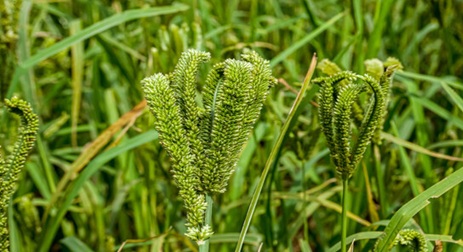 Figure 1: Finger millet (Ragi).
Figure 1: Finger millet (Ragi).
Physical features
A mature plant can grow anywhere between 1.2 m (3.9 ft) and 1.7 m (5.6 ft) tall, and the seeds are tiny, resembling mustard, and either light brown, dark brown, or white in colour. The crop matures in 3-5 months depending on the variety and growing conditions. The seeds are abundant source of dietary fiber, iron, essential amino acids viz., isoleucine, leucine, methionine, phenylalanine, pytates and trypsin inhibitory factors, and are also gluten-free. Finger millet also has many health-promoting benefits such as hypoglycemic, hypocholesterolemic and anti-ulcerative effects. The grain of finger millet has a fundamentally spherical shape, measures around 1-2 mm in diameter, and weighs 2.5 g per 1000 kernels on average. The hue of the grain can range from white to brown. The leaf' structure of the Ragi plant was also studied in relation to drought resistance. The leaves of' the Ragi plants cultivated in soils of' varying drought--65, 47, 40 and 36.5', moisture--were subjected to a series of' hydration aid dehydration. In all four cases the hydration and dehydration isotherms and the hysteresis were nearly coincident. These suggest that the cavities and the open pores in the leaves are nearly of' the same size. Among six plants studied, Ragi was 'ed superior to halsam and paddy in drought resistance, but not tolerant compared with wheat and oats [5]. The crop has a deep but shallow root system and is adapted to rather consistent rainfall conditions. Since the grains can be kept for up to many years without considerable loss from deterioration owing to storage insect pests, finger millet is a crop that is useful as a source of food during times of famine.
Health benefits of ragi
- Ragi is rich in several essential elements, including vitamin C, vitamin E, B-complex vitamins, iron, calcium, antioxidants, proteins, and fibre. It also contains enough calories and healthy unsaturated fats.
- It contains a lot of dietary fibre and immune-boosting elements like iron and copper.
- Ragi is a distinctive plant-based source of high-quality proteins because it contains a number of essential amino acids.
- Finger millet, a wonderful source of natural calcium, helps growing children's bones and its nutritive food for children and pregnant women.
- It has high antioxidant activity.
- Ragi is a powerful source of iron that is a blessing for persons with low blood haemoglobin levels, effectively treating anaemia (Table 2).
- The grain is very nutritious, and has excellent malting properties and widely known for its use of weaning food.
|
Scientific name |
Panicum Sumatrense |
|
Common Name |
In Bengali : Sama, Gujarati : Gajro, Hindi and Kannada : Kuri, Marathi : Save, |
|
Family |
Poaceae |
|
Kingdom |
Plantae |
|
Order |
Poales
|
Table 2: Little Millets (Chama).
Chama, or little millet, is a high-fiber, high-protein grain and cultivated in 750 hectares of land at Attapadi. The species name is based on a specimen collected from Sumatra (Indonesia). Little millet is adapted to both temperate and tropical climates and withstands both drought and water logging. Little millet can be grown on a wide range of soils including waterlogged soils. Deep, loamy, fertile soils rich in organic matter are preferred for satisfactory growth. It can withstand salinity and alkalinity to some extent (Figure 2). Little Millets are sworn both in Kharif-the first two weeks of July-when the monsoon season begins-and in Rabi-the months of September to October. Crops in the Kharif season only need very little irrigation [6]. It is mostly a crop that is fed by rain. However, if the dry spell prevails for longer period, then 1-2 irrigations to be given. Summer crop requires 2-5 irrigations depending upon soil type and climatic conditions.
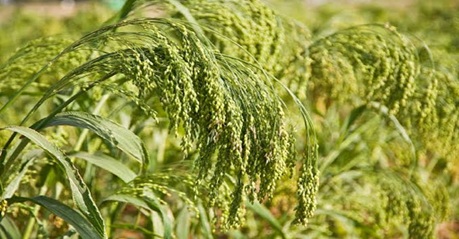 Figure 2: Little Millets (Chama).
Figure 2: Little Millets (Chama).
Physical features
It is a perennial herbaceous plant with straight or folded blades that grows to a height of 30 centimetres (12 inches) to 1 metre (39 inches). Linear leaves with hairy laminae and hairy ligules. The panicles have an awn of 2 to 3.5 mm and are 4 to 15 cm (1.6 to 5.9 in) long (0.079 to 0.138 in). The grain is smooth and round, ranging in length from 1.8 to 1.9 mm (0.071 to 0.075 in). A comparative morphological study of accessions resulted in the recognition of two races. Race nana plants are small (60 cm) to large (170 cm) with decumbent culms that root at the lower nodes before becoming erect to produce flowering culms. Terminal inflorescences are 14–50 cm long, erect, open, and strongly branched, with the branches sometimes clumped at the time of maturity. Race robusta includes plants that are erect, or produce flowering culms from a shortly geniculate base. Flowering culms are 120–190 cm tall and robust. Terminal inflorescences are 20–46 cm long, open, or compact and strongly branched. Open inflorescences are essentially erect, and compact inflorescences become curved at maturity. It is largely a self-pollinated crop; natural cross-pollination can occur up to 3.5%.
Health benefits of chama
- Little Millets are allergen, non-acid-forming, and an excellent addition to the diets of those who practise physical activities. Little millet is a nutrient-dense food that is high in protein, fibre, B vitamins, iron, zinc, and magnesium.
- Its high fiber helps to reduce the fat depositions in the body. Little millet has a significant role in providing nutraceutical components such as phenols, tannins
- Little millet is a low glycemic index food that is also rich in dietary fibre. It is useful for diabetics who must control the rapid rise and fall of blood glucose levels.
- Little millet is high in magnesium, which helps to improve heart health. It is also high in Niacin, which aids in the reduction of cholesterol [7].
- Little millet includes a lot of phosphorus, which is effective for weight loss, cell regeneration, and energy production after an exercise session. It also aids in the detoxification of the body.
- Little millet has been used to treat respiratory conditions such as Asthma.
- Little millet contains no gluten. It is an excellent gluten-free diet alternative for those who have celiac disease or gluten-sensitive enteropathy (Table 3).
|
Scientific name |
Sorghum bicolor (L.) Moench |
|
Common Name |
Juar (Bengali, Gujarati, Hindi), Jwari (Marathi), Jola (Kannada), |
|
Family |
Grass family (Poaceae) |
|
Kingdom |
Plantae |
|
Order |
Poales |
Table 3: Great Millet (Sorghum).
Sorghum[Sorghum bicolor (L.) Moench] is anon-native species for which India is a secondary centre of diversity. It ranks third in terms of area under cultivation and level of output in the Attapadi region and provides the primary source of food for thousands of the poorest and most food insecure people in the semi-arid tropics. When it comes to using water and solar energy to produce food and biomass, sorghum, also known as the C4 plant, is one of the most energy-efficient crops. The crop is naturally drought-tolerant and may be grown in a range of environments. Since both the grain and the stover are highly valued for human and animal nutrition, respectively (Figure 3), sorghum is a dual-use crop in semi-arid regions. It is a short-day plant; hence long nights (dark time) are essential for floral initiation. Every cultivar has a unique critical period of darkness during which its vegetative bud changes into a floral bud.
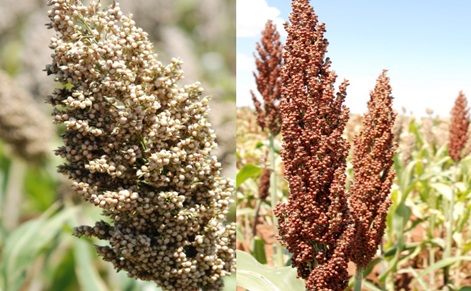 Figure 3: Great Millet (Sorghum).
Figure 3: Great Millet (Sorghum).
Physical features of great millet
The leaf sheaths have overlapping margins and encircle the internodes, depending on internode length. The leaf blade may be 1.5 to 13 cm wide and 30 to 135 cm long. Leaf number can vary from 7 to 30 depending on the cultivar and its growth duration. The uppermost internode bears the inflorescence and is called as peduncle. Sorghum. The sorghum panicles may be 4–25 cm long and 2–20 cm wide, which may be short and compact or loose and open. The inflorescence is a raceme consisting of one or several spikelets. Racemes vary in length depending upon number of nodes and length of internodes. The sessile spikelet varies in shape from lanceolate to almost round and ovate and is sometimes depressed in the middle. The lower glume is usually somewhat conforms more or less to the shape of the spikelet, while the upper one is more convex or boat-shaped. The seed may be enclosed by the glume or may protrude from the glume.
Health Benefits
Sorghum is a nutrient-packed grain that you can use in many ways. It's rich in vitamins and minerals like B vitamins, magnesium, potassium, phosphorus, iron, and zinc. It's also an excellent source of fiber, antioxidants, and protein (Tables 4 & 5).
|
Sl NO |
Crop |
Area under Cultivations Hectares (Ha) |
Season |
||
|
|
|
Panchayaths |
|
||
|
|
|
Agali |
Pudur |
Sholayur |
|
|
1 |
Finger Millet (Ragi) |
200 |
300 |
350 |
May to August, Sept to Dec |
|
2 |
Little millet (Chama) |
175 |
200 |
225 |
May to August, Sept to Dec |
|
3 |
Great Millet/ Indian Millet- Sorghum |
175 |
200 |
225 |
May to August, Sept to Dec |
|
4 |
Pearl Millet (Bajra) |
25 |
50 |
50 |
May to August, Sept to Dec |
|
5 |
Foxtail millet (Thina) |
35 |
35 |
45 |
May to August, Sept to Dec |
|
6 |
Barnyard millet (kadavapullu) |
25 |
30 |
40 |
May to August, Sept to Dec |
|
7 |
Minor Millets (Kodo millet ) |
23 |
30 |
45 |
May to August, Sept to Dec |
Table 4: Major Millets cultivated in Attappady tribal belt during 2020-21.
|
Food Grains |
Carbohydrates(g) |
Protein(g) |
Fat(g) |
Energy (Kcal) |
Calcium (mg) |
Iron (mg) |
|
Finger Millet |
72.0 |
7.3 |
1.3 |
328 |
34.4 |
3.9 |
|
Little Millets |
67.0 |
7.7 |
4.7 |
341 |
17 |
9.3 |
|
Great Millets |
72.6 |
10.4 |
1.9 |
349 |
25 |
4.1 |
|
Pearl Millet (Bajra) |
67.5 |
11.6 |
5 |
361 |
42 |
8 |
|
Foxtail millet (Thina |
60.9 |
12.3 |
4.3 |
331 |
31 |
2.8 |
|
Barnyard millet (kadavapullu) |
65.5 |
6.2 |
2.2 |
307 |
20 |
5 |
|
Minor Millets (Kodo millet ) |
65.9 |
8.3 |
1.4 |
309 |
27 |
0.5 |
|
Source : National Institute of Nutrition Hyderabad |
||||||
Table 5: Nutrition Values of Various Millets in 100 grams.
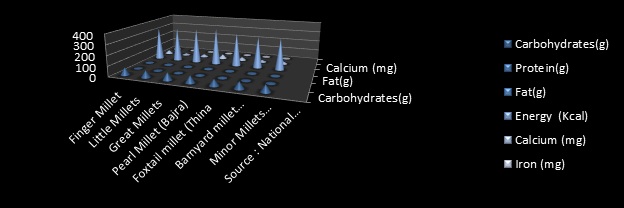
Hill Value Brands
The project aims to preserve traditional millet seed varieties while simultaneously maintaining tribal farmers' food security and way of life. Hill Value Brands sells various millet varieties, including Ragi (finger millet), Chama (little millet), and Cholam (sorghum), as well as other millet varieties, including Thina (foxtail millet), varagu (kodo millet), proso millet, kuthiravali (barnyard millets), and bajra (pearl millet). They also sell different types of pulses, including Cowpee (Thomara Payar) (Figures 4 & 5). Product packaging and branding are handled by the Sholayur Panchayath-based Rushi Kondatta Group. The grains are ground in Maleeshwara Mill, one of Kudumbashree's largest business units [5].
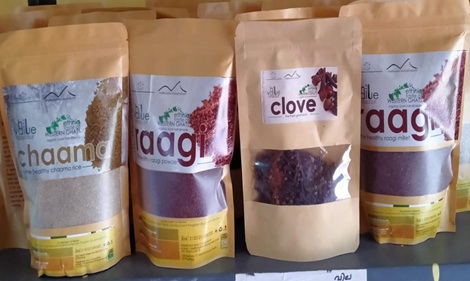 Figure 4: Hill Value Branded Products.
Figure 4: Hill Value Branded Products.
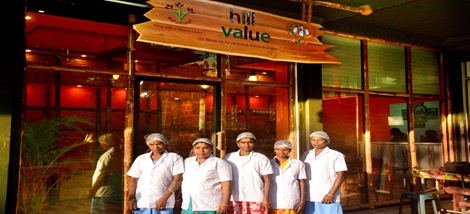 Figure 5: SHG -Hill Value.
Figure 5: SHG -Hill Value.
Results and Discussion
- Traditional tribal populations in Attappady relied on agriculture as their primary source of income. This agriculture was founded on indigenous knowledge acquired through oral tradition and practise over many generations. They had the benefit of having access to the necessary land for cultivation thanks to the prevalence of collective ownership of land among them.
- By eating their traditional foods, the tribal community can lower its infant death rate. This will make it possible for the tribes as a whole, and for new mothers and babies in particular, to live healthy, happy lives.
- Even though Attappady is still leading Kerala in millet cultivation, other regions of the State are also promoting it [2].
- The women in the community are in charge of caring for the millets and are responsible for both their cultivation and the storage of the seeds for the next year.
- It is unexpected that younger generations are expressing interest in millet growing as the Millet Village project is progressing well and the cultivated field has grown to almost 2000 acres. The certification for organic products is in progress.
Challenges
- Large gaps between millet producers, manufacturers, suppliers, consumers, and researchers are among the most significant causes of the lack of consumer awareness.
- Need to raise consumer awareness about using millets as a substitute for staple foods like rice, wheat.
- Improve their nutritional and financial condition of community by consuming a diet high in fibre, minerals, and gluten-free products. Millets aid in the accomplishment of sustainable development objectives.
- The popularity of millets among the general public is being challenged by geographical disparities, different millet varieties, processing methods, ecological benefits, label related sustainability, and label connected to locally produced millet.
- To enhance the quality of output and financial standing of growers and processors, it is also necessary to address millet processing challenges like production support incentives or Minimum Support Price (MSP), a lack of postharvest technologies, improved production and technology methods [7], a lack of public procurement and marketing support, etc.
Conclusion
When plant diversity is lost over an extended period of time, Attapadi's tribal community for agriculture is drained, as well as the population's knowledge and feeling of cultural identity. Agriculture may experience a loss of biodiversity at Attapadi where crops are no longer grown or are being neglected. They were able to grow their customary crops in adequate numbers as a result, ensuring them security in terms of food and nutrition. Farmers who took part in the millet village program have now brought back a defunct traditional food and turned it into their primary source of income. All millets will benefit from guaranteed MSP (Minimum Support Price), which will entice farmers to switch to these crops. Increased household consumption will result from raising consumer awareness of the nutritional advantages of millets and their products, especially among the younger population. Improvements in millets' production, availability, storage, use, and consumption of these food crops will have a substantial impact on the residents of Attpadi Block Panchayath's household food security and nutrition. The three main traditional crops were millets, pulses, and oilseeds. The native community's newborn mortality rate has decreased as a result of sticking to their traditional diet. As a result, they will be able to provide the tribes' members with a healthier way of life, particularly for pregnant women, new mothers, and young children. In 2020–2021, there were 11 baby deaths compared to 31 in 2013. Additionally, they will gain from the Project in terms of a higher standard of living. Young farmers adopted the initiative because of its high protein content, short growing season (60 to 120 days), resistance to climate change, and low water requirement and good source of income and livelihood. Studies to prepare grades, standards, and degrees of polishing are crucial to maintaining the quality of the grain, nutrition, etc., and to prevent the malpractices of indiscriminate polishing because there are currently no standards on the degree of polishing of grain, unlike in the case of rice. Therefore, more technological advancements are needed to match global standards. Due to the millets' high nutritional value, the GOI declared them to be nutri-cereals in April 2018 and added them to the SAMPUSHTA KERALAM - POSHAN ABHIYAAN. Particularly in Attapadi Block, using healthy food crop in their cuisines like rotis, dosas, and porridge (Kanji) aids get the good benefits for both physical and mental health. In order to promote ‘millets’, climate resilient crops as “Nutri-Cereals”and allowed it to include in the Public Distribution System (PDS) so that more farmers may opt the millet cultivation. Millets are being touted as the only grains that could be used for public food systems due to their amazing ability to endure the effects of climate change; therefore it seems essential that they become the "Foods of the Future."
References
- Ramashia S, Gwata ET, Meddows-Taylor S, Anyasi TA, Jideani AIO (2017) Some physical and functional properties of finger millet ( Eleusine coracana ) obtained in sub-Saharan Africa. Food Research International 104: 110-118.
- https://itdpattappady.kerala.gov.in/2018/03/21/millet-village-for-food-security/
- https://www.millets.res.in/
- https://www.sciencedirect.com/topics/agricultural-and-biological-sciences/panicum-sumatrense
- Gomez MI, Gupta SC (2003) Millets, In: L. Trugo and P. M. Finglas, Eds., Encyclopedia of Food Sciences and Nutrition, Elsevier Amsterdam 3974-3979.
- Rao BD, Kandlakunta B, Arlene Christina GD, Sudha Devi G (2017) Nutritional and Health Benefits of Millets. National Food Security Mission
- Kamatar MY, Sreeramaiah H, Meghana, Talawar S, Naik RK (2013) Evaluation of Little Millet (Panicum sumatrense) Land Races for Cooking and Nutritional Composition. Biological and Pharmaceutical Sciences 2: 7-11.
Citation: Sreeni KR (2023) Millet Village Attappady, Kerala: Choice for Healthy Food Consumption, Food Security, Livelihood, Income and Employment. J Food Sci Nutr 9: 151.
Copyright: © 2023 Sreeni KR, et al. This is an open-access article distributed under the terms of the Creative Commons Attribution License, which permits unrestricted use, distribution, and reproduction in any medium, provided the original author and source are credited.

